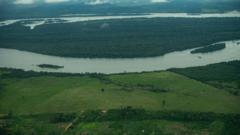A recent report from the University of Maryland highlights alarming trends in global forest loss, indicating an urgent need for intervention.
Record Forest Losses Linked to Increased Fires and Agriculture Expansion

Record Forest Losses Linked to Increased Fires and Agriculture Expansion
Last year saw unprecedented levels of forest destruction, primarily driven by wildfires and agricultural practices.
In a troubling update, the world's forests faced unprecedented loss last year, predominantly due to raging wildfires and expanding agricultural activities. According to an annual survey conducted by researchers at the University of Maryland and the World Resources Institute, approximately 6.7 million hectares of pristine rainforest vanished in 2024 — nearly double the amount lost in 2023. This translates to the staggering loss of forested land at a rate of 18 soccer fields per minute.
For the first time, wildfires emerged as the leading cause of rainforest destruction, marking a shift from the traditionally dominant driver of deforestation: agricultural expansion. Fires were responsible for nearly half of the total forest loss, releasing a shocking 4.1 gigatons of carbon emissions into the atmosphere — more than four times the carbon emissions produced by air travel in 2023.
In addition to the devastating fires, land clearing for various agricultural purposes saw a 14 percent rise, representing the most significant increase in almost a decade. “If this trend persists, it could permanently alter crucial ecosystems and release vast quantities of carbon, further exacerbating climate change and contributing to more extreme fire conditions,” warned Peter Potapov, co-director of the Global Land Analysis and Discovery Lab at the University of Maryland.
As these disquieting trends continue to unfold, the consequences for global ecosystems, biodiversity, and climate stability could be dire, urging immediate action from policymakers and conservationists alike.
For the first time, wildfires emerged as the leading cause of rainforest destruction, marking a shift from the traditionally dominant driver of deforestation: agricultural expansion. Fires were responsible for nearly half of the total forest loss, releasing a shocking 4.1 gigatons of carbon emissions into the atmosphere — more than four times the carbon emissions produced by air travel in 2023.
In addition to the devastating fires, land clearing for various agricultural purposes saw a 14 percent rise, representing the most significant increase in almost a decade. “If this trend persists, it could permanently alter crucial ecosystems and release vast quantities of carbon, further exacerbating climate change and contributing to more extreme fire conditions,” warned Peter Potapov, co-director of the Global Land Analysis and Discovery Lab at the University of Maryland.
As these disquieting trends continue to unfold, the consequences for global ecosystems, biodiversity, and climate stability could be dire, urging immediate action from policymakers and conservationists alike.




















